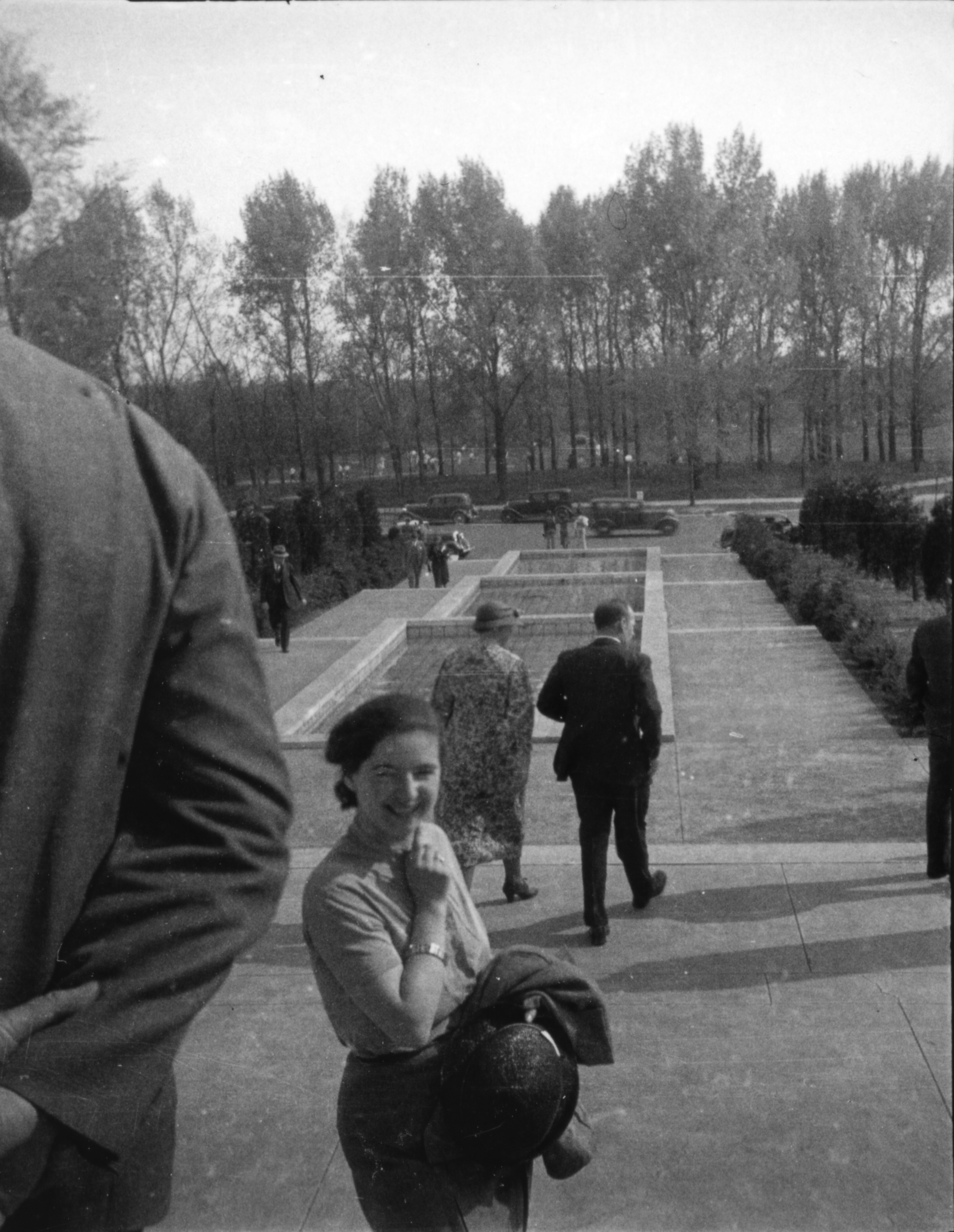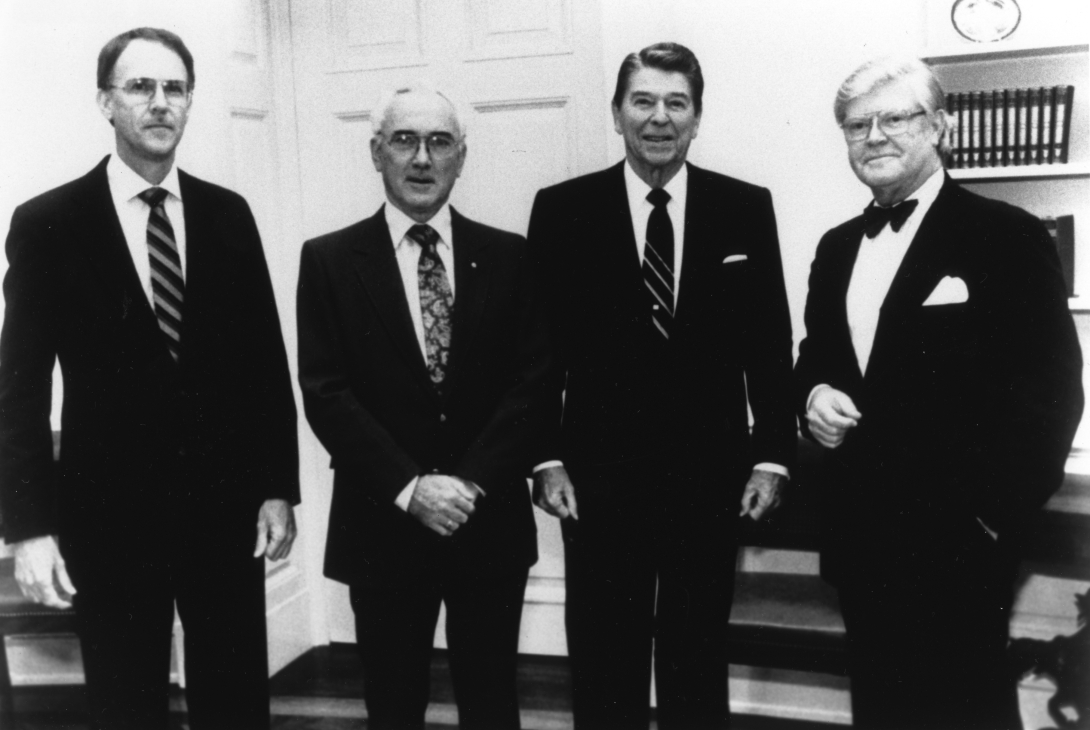Gertrud Porschl-Nordheim outdoors in Washington, D.C. Credit: Photograph by Samuel Goudsmit, courtesy of AIP Emilio Segrè Visual Archives, Goudsmit Collection
Physics with a “Capital” P: An Interactive Photo Series
Physics with a “Capital” P: An Interactive Photo Series
As the U.S. capital, Washington, D.C. has been a hub for musicians performing, politicians legislating, and scientists creating the cutting-edge of technology and information since its founding. This Photos of the Month post covers the work and lives of physicists in the District of Columbia, collected in our visual archives, as well as the photographs’ locations on this interactive map. The post can be read either here, as a traditional blog post, or by using the interactive Google MyMap below to pan around and view photos at the locations where they were taken.
The National Academy of Sciences was founded at the height of the Civil War to provide expert advice to the U.S. government Its founding marked the beginning of a network of scientists with the aim to advise and develop the scientific knowledge of the nation. By the mid-1900s, the NAS had become a hub for research and technology and the permanent home for the National Research Council.
Scientists from around the globe have congregated at the NAS Building from its inception in 1926, as they still do today. These six images were all taken just outside the NAS, as noted physicists from around the world met, conversed, and worked together.
The images in this section span about thirty years of physicists visiting and working at the NAS.
Gertrud Porschl-Nordheim, pictured here, was a German immigrant who moved to the U.S. with her husband, Lothar, during World War II escape the persecution of Jewish people. Gertrud worked under Hertha Sponer (the first female physics faculty member at Duke University) studying the theory behind polyatomic molecules and their molecular spectra.
Jane Dewey, quantum chemist, was a member of the National Research Council and worked on new versions of atomic theory. Her research took her worldwide, from a stint researching with Niels Bohr, the namesake of NBLA, in Copenhagen to the University of Rochester’s optics department. Her work was instrumental in establishing a connection between atomic physics and chemistry in the mid-1900s.
The four men shown conversing represent the intersection of sciences that NAS became known for. Ralph Fowler, statistical mechanist, Allen Shenstone, optical physicist, Toshio Takamine, astrophysicist, and Walter Heitler, quantum physicist, appear to be engaged in lively debate as they exit the building.
Pictured here is Maria Goeppert-Mayer, her husband Joseph Mayer, and their good friend Karl Herzfeld, an Austrian physicist. Maria initially had sought to become a mathematician, but instead switched fields to join the physics community near the inception of quantum mechanics. She worked without pay in the physics department at Johns Hopkins University during the Great Depression, following her husband’s move to the Hopkins chemistry department. In her own career, she collaborated with Enrico Fermi, Max Born, and her eventual good friend, Karl Herzfeld. In 1963, she received the Nobel Prize in Physics, only the second woman to do so in history (and only one of four to this day).
Otto Stern, namesake of the Stern-Gerlach Experiment (a fundamental experiment in quantum theory, demonstrating the quantization of angular momentum) and Nobel laureate, is shown here talking to Gregory Breit, a Russian nuclear physicist, on the steps of the NAS. From the background of the image, it appears a conference has just let out—but they’re not finished talking yet!
Lothar Nordheim (check out his Oral History interview!) was a physicist who worked to develop the atomic bomb with the Manhattan project, pictured here heading into the NAS in the 1950s. He was a senior research advisor at GA Technologies, where he worked developing atomic physics methodologies and seeking more practical applications of his work.
The meetings of national physics organizations often take place in Washington D.C., both as a conveniently-located city and as the seat of the nation. This section covers some of the meetings and work done in D.C., from societies to lectures to meetings with Presidents.
The Atomic Energy Commission, or AEC, was commissioned by President Truman with the goal of improving peacetime atomic energy development, following the end of WWII. Seated at far left of tableere is Elmer Hutchisson, an atomic physicist and a former Director Emeritus at AIP.
On the right is Warren Henry, a chemist and physicist born to two Tuskegee University alumni who grew up on a peanut farm in Alabama. He returned to his parents’ institution as a physics professor for the Tuskegee Airmen, continuing the legacy of Black academics and military experts educated at the Tuskegee Airfield. In this shot, Henry stands with a lathe gifted to Howard University by General Motors.
These are the attendees of the 47th meeting of the American Astronomical Society (AAS), hosted in the Administration Building of the Carnegie Institution in winter of 1931. The keynote address of the meeting covered gravitational dynamics within the solar system, the same year as Eddington’s and Lemaître’s prediction that the Universe is expanding despite the contracting influence of gravity.
This conference room is packed for a reason! Astrophysicist Hong-Yee Chiu, known for his involvement in deep space studies, is credited with coining the term “quasar” (a portmanteau of quasi-stellar, a descriptor of the appearance and activity of these objects which were later discovered to be active galactic nuclei) just one year after this picture was taken.
Part of the appeal of physicists working in Washington, D.C. is the direct access to the United States government, and the opportunity to inform policies made on Capitol Hill and in the White House with cutting-edge science and technology. Pictured here are three physicists in 1987 meeting with then-President Ronald Reagan.
Since the establishment of the U.S., scientists have been involved in the policies of the nation. Even today, physicists are still meeting with the head of state—several pictured here with President George H. W. Bush as his advisors on science and technology. According to Ruthie Vogel, a Society of Physics Students intern working with the United States House Committee on Science, Space, and Technology, the experience in industry and laboratory settings that physicists can offer lends a unique perspective when advising government officials on policy or participating as witnesses in committee hearings. The CHIPS and Science Act, enacted in 2022, is an example of a recent policy-making decision that was informed by physicists. The act provides additional funding to supercomputer development in the U.S., which is a leading field for growth according to many specialists.
Just because Washington, D.C. is a hub for scientists to collaborate doesn’t mean they’re all work and no play! This section covers physicists enjoying life in the nation’s capital.
Val Telegdi is shown here standing outside the Gralyn Hotel, no longer a standing business in D.C. Telegdi likely was not staying here, as he and his wife Lia lived in the area. Telegdi was one of several men referred to as “The Martians” by their colleagues of the time, so nicknamed because they were part of a sudden influx of very intelligent scientists to the United States from the lesser-known country of Hungary, seeming to appear from nowhere. Leo Szilárd jokingly said, “They [extraterrestrial life] are already here among us – they just call themselves Hungarians.” Many of the Martians who immigrated to the United States were Jewish academics, leaving Europe during World War II. Further cementing the nickname, locations on Mars (the real Mars, not its Earthly European equivalent) have been named for several of the scientists.
Sometimes, visiting the seats of government was for fun and not for work. This is Franco Dino Rasetti, a jack-of-all-trades who jumped among physics, paleontology, philosophy, and botany throughout the course of his life, standing in a grassy patch outside the Capitol.
Behold, an astrophysicist in his natural habitat. This is Donald Clayton, American astrophysicist, and his wife, Nancy, at the Air and Space Museum. Clayton is most known for his predictions surrounding supernovae, specifically their radiation output upon explosion.
Linus Pauling, quantum chemist and author, is shown here protesting nuclear bomb testing outside the White House. He conducted research on bond strength in atoms, including their fusion and fission abilities. An outspoken peace activist, Pauling is best known for his two Nobel Prize awards: first the Nobel Prize in Chemistry for his nuclear chemistry research in 1954, and then the Nobel Peace Prize for his work against nuclear arms in 1963.
Pictured are Isidor Rabi and Lee Alvin DuBridge near the Lincoln Memorial, another significant tourist attraction in Washington, D.C. Rabi received the 1944 Nobel Prize in Physics for his work in nuclear physics research, while DuBridge worked primarily in academia as an administrator and professor.
Lia and her husband Val Telegdi lived and worked in the Washington, D.C. area for much of their professional lives after emigrating from Hungary together. Here is Lia near the Tidal Basin, pictured with some of D.C.’s iconic cherry blossoms in bloom.
Visiting the Supreme Court to see where the Constitution is studied and upheld is a timeless Washington, D.C. outing. Shown here are Kevin Marvel, Executive Officer of the American Astronomical Society, and Lee Ann Wilson, Iowa State astrophysicist, on the steps of the Court.
These are just a few of the people who have moved throughout Washington, D.C. during its history, and more are passing through every day. The locations in the map are largely still active in serving their original purpose, whether as seats of government, hubs for scientific research, or simply landmarks that tourists still visit.
References:
The Atomic Energy Commission. United States Department of Energy. (n.d.). https://www.energy.gov/management/articles/history-atomic-energy-commission
Clayton, D. (n.d.). Supernovae and the Origin of the Solar System. Space Science Reviews. https://adsabs.harvard.edu/full/1979SSRv...24..147C
Hajo, C. M. (n.d.). Dewey, Jane Mary (1900-1976). Jane Addams Digital Edition. https://digital.janeaddams.ramapo.edu/items/show/2077
Hutchisson, Elmer, 1902-. Physics History Network. (n.d.-a). https://history.aip.org/phn/11406003.html
Kuzemsky, A. L. (n.d.). Biography of L.W. Nordheim (1899-1985). Bogoliubov Laboratory of Theoretical Physics. http://theor.jinr.ru/~kuzemsky/nordbio.html
Los Angeles Times. (1985, October 4). Renowned Nuclear Physicist Lothar Nordheim. Los Angeles Times. https://www.latimes.com/archives/la-xpm-1985-10-04-me-5035-story.html
The Martians. Base Camp. (n.d.). https://codanec.eu/cultural_treasure/the-martians/
Meetings of the AAS: 1927-1932. Historical Astronomy Division. (n.d.). https://had.aas.org/resources/aashistory/early-meetings/1927-1932#47
National Academy of Sciences - http://www.nasonline.org. (n.d.). Academy History. Overview: NAS History. https://www.nasonline.org/about-nas/history/
The Nobel Prize in Chemistry 1954. NobelPrize.org. (n.d.).
https://www.nobelprize.org/prizes/chemistry/1954/pauling/biographical/
The Nobel Prize in Physics 1963. NobelPrize.org. (n.d.). https://www.nobelprize.org/prizes/physics/1963/mayer/biographical/
Ralph Fowler - Biography. Maths History. (n.d.). https://mathshistory.st-andrews.ac.uk/Biographies/Fowler/
Shenstone, A. G. (Allen Goodrich). Physics History Network. (n.d.-b). https://history.aip.org/phn/11609019.html
United States National Aeronautics and Space Administration. (2011, September 13). Hong-Yee Chiu (b. 1932). Smithsonian Institution Archives. https://siarchives.si.edu/collections/siris_arc_290743
Black History MIT. Warren E. Henry, ca. 1943. Massachusetts Institute of Technology. https://www.blackhistory.mit.edu/archive/warren-e-henry-ca-1943






















Add new comment
Val and Lia Telegdi
My parents, Mel and Marilyn Schwartz, adored the Telegdis - Val and Lia often visited out family in San Francisco. It is wonderful to see their photos here.
Dates ?
How about adding dates to the pictures or, if the date is unknown, indicating this fact. Time as well as space is important in situating an image and, speaking as a historian of science, often times more important!
(By the way, the list of non-matched "References' at the end is not satisfactory from this point of view)
Thanks,
Jim Ritter
Sorbonne Université, Institut de Mathématiques de Jussieu-Paris Rive Gauche.
Campus Pierre et Marie Curie,
case 247, 4 place Jussieu,
75252 Paris cedex 5, France
dates
Dear Jim Ritter,
Thank you for your comment about dates. The caption on each picture contains a hyperlink to the image in our visual archives where, if we have it, date information is present. Ex. Lia Telegdi with Cherry Blossoms Credit: AIP Emilio Segrè Visual Archives, Telegdi Collection, gift of Judith Goodstein
We'll keep your suggestion about including the date in the text of the caption in the future.
Thank you,
Corinne
Corinne Mona
Assistant Librarian, Niels Bohr Library & Archives
Add new comment